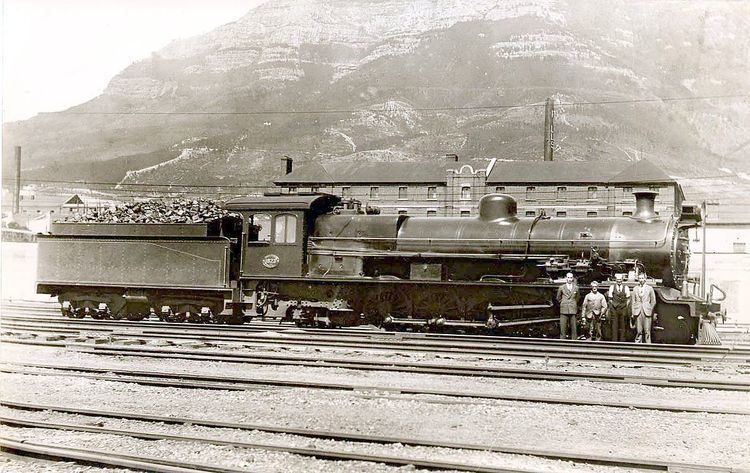In service 1912-1925 Rebuild date c. 1930 | Rebuilder South African Railways | |
 | ||
Locomotive Class 12, Class 12A, Class 12B, Class 14, Class 14A, Class 14B, Class 15, Class 15A, Class 16, Class 16A, Class 16B, Class 16C, Class 20, Class MC1, Class MH, Class MJ Designer South African Railways(D.A. Hendrie) Builder Baldwin Locomotive WorksBeyer, Peacock and CompanyHenschel & SonJ.A. MaffeiNorth British Locomotive CompanyRobert Stephenson and CompanyVulcan Foundry | ||
The South African type MP1 tender was a steam locomotive tender.
Contents
- Manufacturers
- Characteristics
- Locomotives
- Classification letters
- Modifications
- Reclassification to Type XP1
- Rebuilding to Type MR
- References
The Type MP1 tender first entered service in 1912, as tenders to the Class 12 4-8-2 Mountain type steam locomotives which were acquired by the South African Railways in that year.
Manufacturers
Type MP1 tenders were built between 1912 and 1925 by Baldwin Locomotive Works, Beyer, Peacock and Company, Henschel & Son, J.A. Maffei, North British Locomotive Company, Robert Stephenson and Company and Vulcan Foundry.
The South African Railways (SAR) placed 46 Class 12 Mountain type locomotives in service between 1912 and 1921. The locomotive and tender were designed by D.A. Hendrie, who had been appointed as the first Chief Mechanical Engineer of the SAR upon its inception in 1910. The Class 12 was the first locomotive design to originate from the newly established SAR and was acquired to haul coal between Germiston and Witbank. The Type MP1 first entered service as tenders to these locomotives.
Characteristics
The Type MP1 was the first of a standard tender type which, by fitting an engine drawbar to suit the class of engine to which it is coupled, was eventually to be used on all the Hendrie-designed locomotives. The tender had a coal capacity of 10 long tons (10.2 tonnes), a water capacity of 4,250 imperial gallons (19,300 litres) and a maximum axle load of 13 long tons 15 hundredweight (13,970 kilograms).
Locomotives
Sixteen locomotive classes, built by seven manufacturers, were delivered new with Type MP1 tenders, which were numbered for their engines in the number ranges as shown. An oval number plate, bearing the engine number and often also the tender type, was attached to the rear end of the tender.
Classification letters
Since many tender types are interchangeable between different locomotive classes and types, a tender classification system was adopted by the SAR. The first letter of the tender type indicates the classes of engines to which it could be coupled. The "M_" tenders could be used with the locomotive classes as shown, although engine drawbars and intermediate emergency chains had to be replaced or adjusted to suit the target locomotive in some cases.
The second letter indicates the tender's water capacity. The "_P" tenders had a capacity of 4,250 imperial gallons (19,300 litres; 5,100 US gallons).
A number, when added after the letter code, indicates differences between similar tender types, such as function, wheelbase or coal bunker capacity.
Modifications
Most of these tenders were modified by shortening and raising the sides of the coal bunker, in effect making the coal at the rear of the bunker more easily accessible to the stoker and apparently without affecting the tender's coal capacity.
Reclassification to Type XP1
At some stage, probably after its engine was withdrawn from service c. 1937, the intermediate draw and buffing gear of Type MP1 tender no. 1634, off a Class MC1 Mallet locomotive, was altered to suit Class 10 4-6-2 Pacific no. 746. This modification converted no. 1634, which was also modified by shortening and raising the sides of the coal bunker, to the sole Type XP1 tender.
Rebuilding to Type MR
During the 1930s, some of the Type MP1 tenders were rebuilt by the SAR by mounting a completely new upper structure on the existing underframe. The modification was done to drawings approved by Chief Mechanical Engineer A.G. Watson in 1929, in respect of Type MP1 tenders of the Classes 12, 12A, 12B, 14, 14A, 14B, 15, 15A, 16, 16A, 16B and 16C. These rebuilt tenders had a more modern appearance, with flush sides all the way to the top of the self-trimming coal bunker. The new tank increased the water capacity from 4,250 to 4,600 imperial gallons (19,300 to 20,900 litres) and these rebuilt tenders were therefore reclassified to Type MR.
